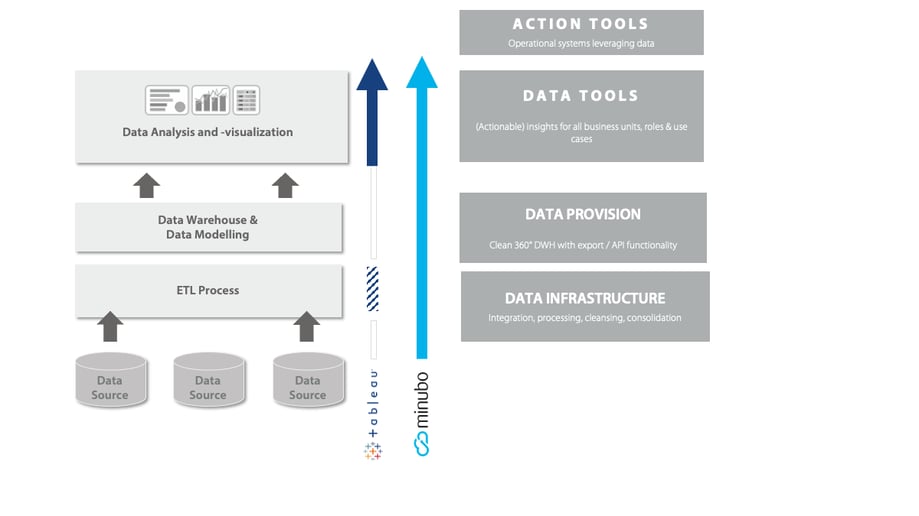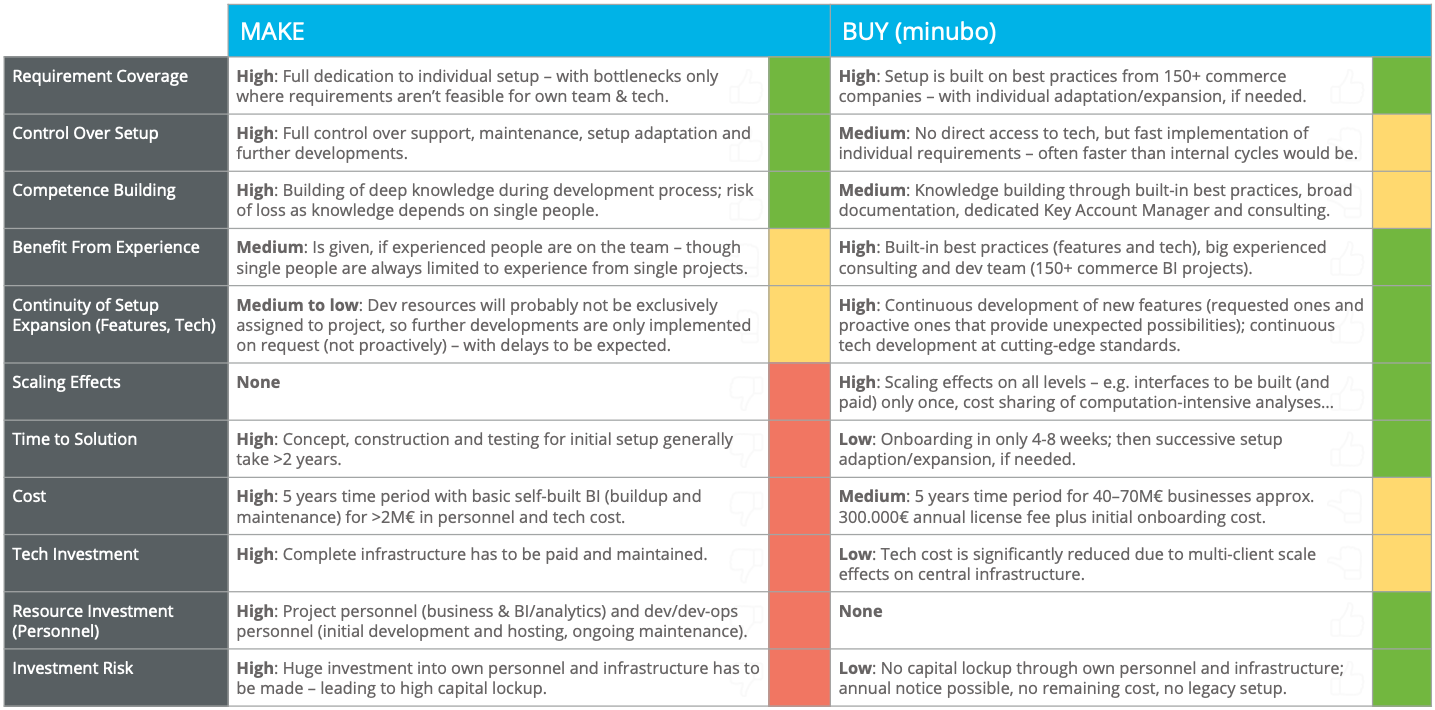This is what this blog-series is all about:
Tableau, Looker, Incuda, Power BI or Supermetrics - they all do some kind of magic with data and often this is labelled as Business Intelligence (BI), but where exactly is the BI? The selection of software solutions is large and now it has become difficult to keep track of all the offerings. This guide provides a remedy in the form of 4 consecutive blog articles - based on our comprehensive BI-centered consulting and development activities in the online sector. For everyone who wants to understand the differences. And especially for online retailers.
Episode directory
- Business Intelligence - see the big picture. Retailers have to consider this in their BI decision
- Supermetrics vs. minubo - Business intelligence software compared
- Looker vs. minubo - Business intelligence software compared (coming soon)
Episode 2
Comparing Business Intelligence Software - Tableau vs. minubo
A Business Intelligence (BI) solution helps to collect, save, analyze and visualize data - we looked at this in more detail in the last article. A BI infrastructure requires four elements (data sources, ETL process, data warehouse, data analysis and visualization), which are implemented either using a standardized and complete BI solution or a specially assembled BI stack.
Many software providers are committed to BI, but in the following article we will take a closer look at which requirements they really cover, using a classic BI architecture. For this article, we have selected Tableau to illustrate how this solution can be integrated into a classic BI infrastructure, what the prerequisites for a successful project implementation are, and where the differences, advantages, and disadvantages in comparison to a standardized and complete BI solution, such as minubo, lie.
Some Context: The Difference Lies in the Architecture
To make the whole thing a little clearer, let's take another look at the structure of a Business Intelligence solution. In Article 1 we divided the BI architecture into four levels: data sources, ETL process, data warehouse, and data analysis and visualization. The graphic clearly shows which part of the data value chain Tableau and minubo cover and where the support of other solutions is necessary.
Tableau and minubo in Comparison
Tableau - BI or Visualization Tool?
Many retailers are probably familiar with Tableau. A top solution when it comes to illustrating and visualizing data. In addition to Power BI, Google Data Studios or QlikView, Tableau is probably one of the best-known visualization tools on the market. The software is a powerful tool when it comes to the range of functions and flexibility for ad-hoc data manipulation and display, and it offers numerous options for creating clear reports and dashboards.
For a long time, Tableau was only available as an on-premises solution, which means that the tool is managed by the user on their own computer. The company now also offers hybrid and cloud-based models for its customers. Entry for small companies is only possible at a very high cost. This is due, on the one hand, to price-intensive licenses and, on the other hand, to a minimum purchase of these.
Tableau describes itself as ‘software for Business Intelligence and Analytics’. However, if you take a closer look at the solution, you will find that - in contrast to a complete BI solution - it only covers a sub-area of Business Intelligence (see the figure above). The challenge with Tableau is that it does not bring (or only partially brings) a strong data infrastructure, that is, ETL process and data warehouse, with it.
If you use Tableau without an ETL or data warehouse in front of it, you can visualize the data from different systems, but you must invest a lot of time in complex work, since your own deduplication and extensive data modeling must be carried out, and in the end, the user neither gets to see consolidated nor meaningful data. This means that, ideally, a fully integrated, structured, high-performance database is required as a supplier to be able to transform complex data into the basis for correct decision-making. Because, as we know, the real challenge lies in building high-performance hosting, the interfaces to source systems, data integration and transformation, data modeling and the provision of data - when it comes to creating real added value.
A Complete BI Solution, Many Advantages
A complete Business Intelligence solution like minubo provides a holistic solution and covers a wide range of requirements for a BI solution: from data integration, ETL, database, data model to visualization, analysis and automation - the big picture, so to speak. With the integration of the data from all relevant systems (POS, ERP, online, store, etc.) into a holistic database, minubo creates the basic requirements for the successful use of visualization applications and can be used in addition to Tableau to increase quality. In addition, there is the option to flexibly integrate additional data into other third-party systems (action tools) in order to make them usable and to supplement or replace individual components.
minubo itself impresses with its own strong front end for making data usable, which offers numerous flexible visualization options. However, if you want to go one step deeper in this area, it can make sense to combine minubo with Tableau or a similar product - that is, special solutions for the visualization area. minubo thus guarantees that these tools develop their full benefit and earn the trust of users.
Requirements Coverage at a Glance
|
|
Tableau |
minubo |
|
Level 1: Data Source |
Tableau supports connections to a variety of internal and external data sources across the enterprise. This includes classic data sources such as Excel and text files, but above all Tableau specializes in interfaces to databases. It is therefore primarily a matter of connections to technical systems and less to operational systems. For systems from the commerce sector, for example, only a very limited set of sources are available. If the desired system is not there, this means for the customer that they must extract the data independently with the help of other software solutions (such as Supermetrics and so forth) - a process that not only requires technical expertise but also time. |
In contrast to Tableau, minubo works with connectors to all common operational systems. Thanks to many standard interfaces and individual data pipelining, the data from a wide variety of source systems (such as CRM, shop systems, web tracking, ERP or merchandise management, etc.) can be integrated directly into minubo using a “plug and play” approach and then processed further. The time required is thus minimized and the expertise of the different source systems is covered; Retailers do not have to set this up in-house but can start right away. |
|
Level 2: ETL |
ETL significantly increases the availability and value of data and its quality. Tableau has not had its own ETL process for a long time. In the meantime, there is Tableau Prep, its own ETL platform, which is still subject to the self-made brand. In other words: if you want to use Tableau Prep, you must bring technical expertise and time with you again. |
minubo has its own ETL process, which was built in Apache Spark, an analytics engine for big data processing. This guarantees high performance and efficiency and, above all, full scalability. For the customer, this means no additional effort and access to reliable data in correctly validated form, which is automatically made available every morning. |
|
Level 3: DWH |
The Data Warehouse (DWH) is mass storage that is optimized to provide large amounts of data for analytical data queries with high performance. Tableau does not have its own DWH. This must also be covered as part of the BI infrastructure by another software provider, such as Snowflake or Exasol. |
As a complete BI stack, minubo is equipped with a flexible analytics database as a DWH as well as an integrated data model, which now has almost 1,000 key figures, attributes, and metrics - tailor-made for the reporting and analytics needs of commerce companies. Based on Elasticsearch, a particularly fast search engine technology, minubo has developed the analytics database, which guarantees outstanding performance at all levels of data retrieval - from the highest aggregation to the raw data level. This not only ensures that minubo can offer a wide variety of data tools, but also enables the data from minubo to be used flexibly in third-party systems. |
|
Level 4: Visualization & Analysis |
In addition to the ability to carry out ad hoc analyses, the focus at Tableau is clearly on visual analysis. The tool offers an incredibly large number of possible forms of visualization and great flexibility when it comes to displaying, manipulating, or grouping data. With a large selection of different diagram types, graphs, and curves, it is possible to keep an eye on relevant key figures and thus make reports easy to understand and quickly understandable for everyone. Due to this large variety of options, however, the operation becomes quite complex and is primarily designed for use by analysts. In addition, Tableau offers the option of individually and flexibly adapting colors, background, font and logos to the corporate design and content and saving them as a template - a great time saver when it comes to creating dashboards and reports that conform to CI. |
minubo itself impresses with its own strong front end, which, thanks to its ease of use, enables not only analysts but the entire organization to establish a better, data-driven decision-making culture and intelligent process automation. The comprehensive web-based tool set not only includes a variety of different visualization options, such as dashboards and reports, but also offers access to a high-performance data warehouse and thus the possibility of operationalizing data and using other third-party systems (e.g., marketing systems, commerce platforms, external analytics & reporting, external AI, and machine learning modules, etc.). Users can establish a real data-driven work culture with tools such as segmentation, proactive alerting, and flexible ad-hoc analyses. Another important difference: minubo is not a generic tool but specializes in retail cases - and with the integrated data model (almost 1,000 predefined eCommerce key figures, attributes, and metrics) and best practice reports and analyses, it offers a concrete tool that is successful in retail to work data-driven. |
Business Intelligence Setup – The Choice is Clear
So now I have to decide: 1) I build my own individual BI stack in an in-house BI project, which is supplemented by other software solutions in the data infrastructure in addition to Tableau or 2) I rely on a standardized complete Business Intelligence solution - like minubo, which does not allow direct tech access, but instead, it brings tech and tools in one solution.
YES, I can put together the software stack for my own in-house BI project myself and individually according to my taste, and YES, I have full control over support, maintenance, setup and configuration, expansion, and further development and YES, also the structure of expert knowledge and data infrastructure competence during the development process is an asset, BUT ...
... such a BI project is not only extremely lengthy and terribly expensive, until it is used proactively, it is also very risky. Since there are no economies of scale, such as the construction of interfaces or cost sharing of computationally intensive analyses, a self-built BI project is associated with large investments and makes you dependent on the expertise of one or a few people in the company, or externally purchased resources, for the development and implementation. Additionally, further development and maintenance involves the same shortcomings.
In addition, the question arises as to how user-friendly this solution will be in the end, because self-service is only possible in very few cases and IT professionals and analysts often end up having to extract data for business stakeholders on request.
So why end up with more work, costs, and a mostly mediocre solution in the end, when it can be done easily, quickly and from a single source?
You can get more details as well as detailed insight into the topic in a blog by minubo CEO Lennard Stoever. If you should decide on your own BI project, there are two further recommendations:
- minubo's Commerce Intelligence Blueprint for the basic approach to a BI project and its most important success factors.
- The “Commerce Reporting Standard” initiative by minubo and Project A, which has a matrix of transaction metrics and provides start-up assistance related to the data model.
Conclusion
Visualization tools like Tableau are very strong solutions when it comes to presenting data in a clear manner. They offer companies the opportunity to intuitively create reports and dashboards according to their own requirements, thus improving the monitoring of business processes and providing quick insights into development trends. And yes, of course I can also query data from various source systems ad-hoc using standard connectors in the aforementioned visualization tools and possibly also model them ad-hoc, but in order to use these tools in a targeted manner and actually use their strengths, a solid data infrastructure is required.
Business Intelligence solutions such as minubo provide a holistic solution and, in addition to their own visualization options, they offer a high-quality, complete, and well-structured database on the basis of which meaningful and reliable results can be presented. Due to the interfaces to relevant source and third-party systems, the effort of connection and data integration is extremely low and can be implemented without extensive IT work. With just a few clicks, the data is integrated and automatically updated daily.
The core differentiating feature: with minubo, a comprehensive set of key figures for digital retail as well as best-practice analyses and reports are supplied ready-made, that is, out of the box. This saves the long start-up time, the definition effort, and the need to obtain external expertise and it brings tangible analysis results and thus real added value from day 1.
All of this adds up to another reason why a BI project with a standardized and complete Business Intelligence solution can be realized much faster - we are talking about a few weeks instead of years of implementation time - and significantly cheaper and more cost-effectively - we are talking about a cost burden that is up to 5 times lower.
Interested in more? An example of the successful interaction of a visualization tool, in this case Power BI, and minubo is shown by the Danish fashion retailer Masai Clothing Company.


 nach Wunsch auch mit Videocall
nach Wunsch auch mit Videocall

